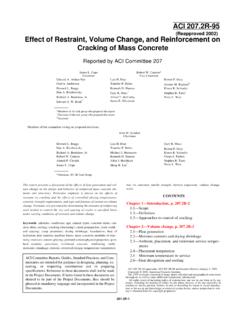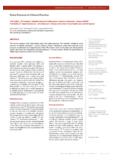Transcription of Shrinking Lung Syndrome: A Pulmonary Manifestation of ...
1 Vol. 4, No. 2, 2004 The Journal of Applied Research328for dyspnea. Two adults who showedsevere arthritis in their hands had beenpreviously diagnosed of rheumatoidarthritis. No visceral involvement wasfound other than lung results showed normal mus-cle enzyme values. Chest x-ray and CTscan revealed small lungs withoutparenchymal or pleural function tests indicated thepresence of restrictive disease with nor-mal carbon monoxide transfer. Thealveolar-arterial gradient was withinnormal limits. Maximal inspiratory pres-sure was slightly low and maximal expi-ratory pressure was within normallimits. Sleep studies ruled out nocturnalhypoventilation and mild sleep-apneasyndrome was observed in 2 previousheavy snorers. During the follow-upperiod (10 to 46 months) none of thepatients : Shrinking lung syndromeaffects a small proportion of patientswith lupus and may also occur in chil-dren. It should be suspected in patientsShrinking Lung syndrome : APulmonary Manifestation ofSystemic Lupus ErythematosusDiurnal Findings and Nocturnal EventsElsa Naval, MD*Christian Domingo, MD, FCCP*Jordi Gratac s, MD Montserrat Bosque, MD Manel Luj n, MD*Albert Mar n, MD**S.
2 Pneumologia, S. de Reumatologia, S. de Pediatria, Corporaci Parc Taul , Institut UniversitariParc Tauli-FPT Universitat Autonoma de Bellaterra, Barcelona, SpainKEY WORDS: Shrinking lung syn-drome, systemic lupus erythematosus,nocturnal eventsABSTRACTO bjectives:To describe the diurnal andnocturnal findings of 4 adults (3 women)and one child with systemic lupus ery-thematosus and Shrinking lung :A prospective :A 750 teaching-bed-hospitalwith a reference population of 350, :Clinical history, bloodanalysis, imaging test, Pulmonary func-tion tests, maximal inspiratory and expi-ratory pressures, arterial blood gases,and sleep and Results:Patientswere referred to the pneumology serviceThe Journal of Applied Research Vol. 4, No. 2, 2004329with lupus who present exertional dysp-nea without apparent cause. The condi-tion does not seem to affect sleepphysiology, the clinical features tendtowards stabilization regardless of thetreatment prescribed. The origin of thesyndrome seems to be a self-limitedmyositis of the lupus erythematosus (SLE) isan inflammatory disease of unknownorigin.
3 It occurs most frequently inwomen at fertile ages, though it has alsobeen reported in males, children, and theelderly. Any organ or system may beaffected: the skin, musculoskeletal sys-tem, kidney, nervous system, digestivetract, cardiocirculatory system or percent of SLE patients pres-ent pleuropulmonary is the most frequent disorder,occurring in approximately 45% ofcases. Other forms of Pulmonary impair-ment are lupus pneumonitis (acute orchronic), Pulmonary hemorrhage, oblit-erating bronchiolitis with organizedpneumonia, Pulmonary vascular diseasein the form of Pulmonary thromboem-bolism and plexogenic pulmonaryhypertension, interstitial pulmonaryimpairment (more frequent in otherconnective tissue disorders such asrheumatoid arthritis or systemic sclero-sis), and finally impairment of the respi-ratory muscles, especially of thediaphragm, which may lead to a respira-tory disorder without visceral lunginvolvement. This condition is known asshrinking lung syndrome (SLS).
4 1 Todate, the experience on the evolution ofthese patients is controversial and thereis no information about nocturnal respi-ratory aim of this study is to describethe diurnal and nocturnal behavior of 4adults and one child with SLS and AND METHODSP opulation Four adult patients (3 women and 1man), aged between 51 and 76, referredto the Pneumology Service for exertion-al dyspnea and one pediatric patientreferred to the Pediatric Service at ourhospital for fever and pleural following examinations were per-formed in all patients during their firstvisit to the Pneumology Service: clinicalhistory, with special attention to lengthof evolution of the SLE and its form ofpresentation; physical examination;blood analysis including erythrocyte sed-imentation rate, hemogram, generalblood biochemistry (antinuclear anti-bodies, muscle enzymes, C-reactive pro-tein, Rheumatoid factor); imaging tests(x-rays of chest, hands and feet andchest computed tomography scan [CTscan]) and Pulmonary function tests(PFTs).
5 Pulmonary function tests werecarried out in our Pulmonary functionlaboratory, which is equipped with auto-mated PFT equipment (MedGraphicssystem 1070 Series 2E/1085) for pul-monary volume, diffusion, spirometrytesting and an automated pletysmo-graphic cabin for Pulmonary volume andairway resistance inspi-ratory pressure (MIP) and maximalexpiratory pressure (MEP) were alsodetermined using a manometer(Sibelmed manometer 163, Sibel ,Barcelona, Spain) Arterial blood gaseswere measured with a radial punctureusing local anesthesia, while the patientwas breathing room air (RadiometerABL 500).In the adults, respiratorypolysomnographies were performedwith a Nocturnal Simplified Polygraph(Sibel home 300, Sibel , Barcelona,Spain), which records nasal/oral airflow(nasal cannula and thermistor), chestwall impedance, oxygen saturation, car- Vol. 4, No. 2, 2004 The Journal of Applied Research330diac frequency, snoring, and body the adults, the studies wereperformed in the sleep laboratory of ourhospital.
6 In the pediatric patient, a noc-turnal domiciliary pulse-oximetry(Pulsox 3-Minolta) was population reference val-ues were the pediatric patient,the reference values of the SpanishSociety of Lung Disease (SEPAR)4andPolgar values were MIP andMEP, Wilson s predicted values follow-up all the comple-mentary examinations were were controlled on an outpa-tient basis at our hospital s pneumologyand rheumatology the past fourteen years, 126 cases ofSLE have been diagnosed at our hospi-tal. Only 5 cases of SLS have beendetected: 4 adults and one child (agerange, 10 to 76).Clinical HistoryAll patients met the AmericanRheumatism Association (ARA) criteriafor SLE. Two cases presented strikingarticular impairment with high degree ofdeformation and little erosion (Figure1); they were classified as an overlapsyndrome with SLE and rheumatoidarthritis (also called Rupus ). In 4patients, SLS presented as dyspnea oneffort, 10, 12, and 20 years after SLEdiagnosis. In one of the cases, a patientwith a prior diagnosis of seronegativeRA, SLE, presented as was the predominant respi-ratory symptom and the reason for con-sultation.
7 The dyspnea did not progressduring follow-up (in one patient the dys-pnea was difficult to evaluate due to theextent of her articular limitations).BiologyIn addition to the alterations typical ofSLE, all patients had normal antinuclearantibody titers, rheumatoid factor wasnegative, and normal levels of muscleenzymes (CK and aldolases) at the timeof diagnosis were obtained. During fol-low-up no increase in CK or aldolasevalues was observed. Renal functionremained unimpaired in all FunctionPatients presented a restrictive ventila-tory alteration without alteration in car-bon monoxide transfer (normal KCO),stable MEP, but low MIP. Arterial bloodgases showed a normal or slightlyincreased alveolar-arterial oxygen values are shown in Table1. The mean values of the PFTs in theadults showed a restrictive ventilatoryalteration: FEV1/FVC: 74 2%; FEV1:1482 mL 262 mL (64 8%); FVC:2010 mL 434 mL (63 4%); TLC:3665 mL 1143 mL (68 6%); RV:1417 516 mL ( 71 9%).
8 CO transferstudy showed: DLCO: 60 10 %;DLCO mL/min/mmHg: ; KCO(DLCO/AV): 91 13 %; KCO(DLCO/AV)mL/min/mmHg: ;MEP %: ; MIP %: 10%. The values of the pediatric patientare the following: FEV1/FVC: 97%;FEV1: 1340 mL (56%); FVC: 1380 mL(71%); MIP 74 cmH2O; MEP: x-ray of patient 1. Observe thedecreased number of intercostal spaces aswell as the absence of pleural and parenchy-mal lung Journal of Applied Research Vol. 4, No. 2, 2004331 Respiratory PolysomnographyTwo adults, who had a history of snoringbefore the beginning of the diseaseshowed a mild sleep apnea syndrome (SAS) but none referred diurnal hyper-somnia. In the other 2 cases, respiratorypolysomnography was completely nor-mal. In the pediatric patient, the noctur-nal pulse-oximetry was normal (MeanSp02: ; Time spent Sp02<90%:0,0%; 4% average dips/hour: ). Thesleep studies also ruled out episodes ofhypoventilation (see Table 2). The poly-graphic studies were repeated after ayear and no significant changes Results Chest x-ray in this condition shows acharacteristic elevation of thediaphragm, with reduction of the num-ber of intercostal spaces (between 5 and7) and, as a result, a reduction in lungsize.
9 Chest x-ray did not reveal intersti-tial infiltrates but in 2 patients there wasbibasilar atelectasis associated with theelevated diaphragm. CT scan confirmedthe absence of any interstitial At the time of diagnosis the patientswere receiving treatment with oral corti-coids (dose 4 to 20 mg/day). One patientwas also administered delayed theo-phylline at 10 mg/Kg/weight at the onsetof symptoms without any of follow-up varied between 18and 46 months. None of the subjects pre-sented progression of dyspnea, analyticalchanges in the immunological study,radiological images, or in the nocturnalstudies. The only change observed in therespiratory function study was a reduc-tion of the MIP in one case, at 3 monthsand 2 years after diagnosis of the 1. Pulmonary Function Test*Patient 1 Patient 2 Patient 3 Patient 4 FEV1/FVC (%)77747174 FEV1(%)76646057(mL)1290152018401280 FVC(%)68666158(mL)1670205026101710 TLC(%)65727562(mL)2920340053502990VC(%)6 1757061(mL)1580240031801890RV(%)71628569 (mL)1340106021701100 DLCO(%)73645152 DLCO (mL/min/mmHg) (%)108827898 KCO (mL/min/mmHg) (%)97 *757780 MEP(%)128828686*Data given in a percentage form (%) are percent of predicted normal values.
10 FEV1indicates forced expiratory vol-ume in the first second; FVC, forced vital capacity; TLC, total lung capacity; VC, vital capacity; RV, residual volume;DLCO, diffusion lung capacity; KCO, DLCO/VA (alveolar volume), MIP, maximal inspiratory pressure; and MEP,maximal expiratory pressure. *During the following of MIP value decreased 48%.Vol. 4, No. 2, 2004 The Journal of Applied Research332 DISCUSSIONThe connective tissue diseases causemultisystemic alterations, and theirimpact on the lung is particularly impor-tant. The type of Pulmonary impairmentin SLE varies widely. Possibly the leastcommon Manifestation is the SLS, whichin fact is exclusive to clinicalpresentation of SLS tends to be suba-cute dyspnea, without any other accom-panying respiratory x-ray reveals reduced lung vol-umes (with at most 7 intercostal spaces)without evidence of occupation of thepulmonary fields or pleural indicates a restrictive venti-latory defect that is confirmed byreduced lung volumes.






